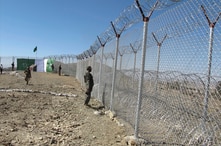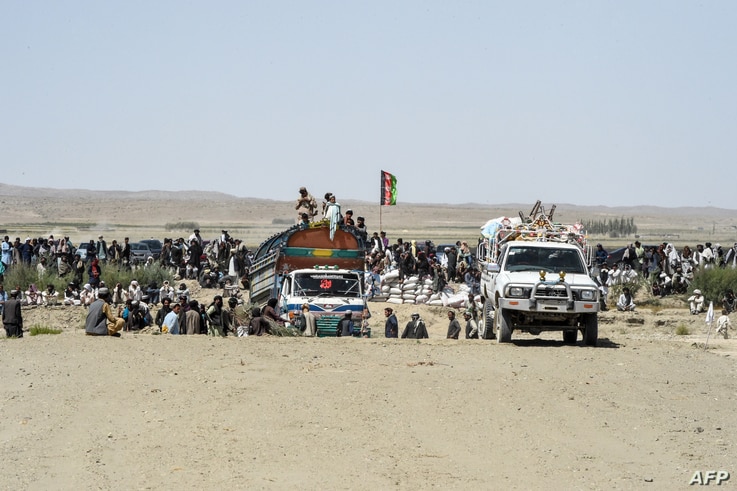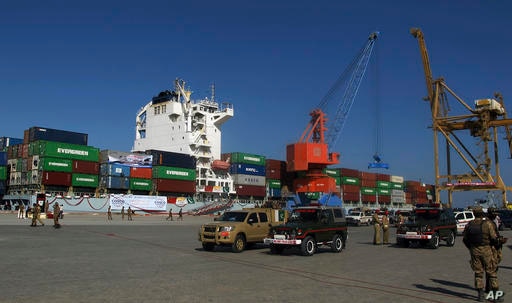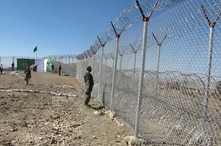Pakistan’s border fence with Afghanistan marks a major milestone in Islamabad’s efforts to improve security along its western border, but some Pakistani traders say they are concerned the project will harm their livelihoods by disrupting centuries-old trade routes.
Pakistan’s military said in early December that it would have the country’s 2,600-kilometer border known as the Durand Line fenced off within the next two months.
 Pakistan Says Afghan Border Fence Nearly CompleteA robust fence has already been erected along 83% of the historically porous border
Pakistan Says Afghan Border Fence Nearly CompleteA robust fence has already been erected along 83% of the historically porous border
The country’s foreign minister, Shah Mahmood Qureshi, told journalists last week that the fencing would prevent illegal crossings and reduce infiltration by terrorists. The $500 million project consists of two wire fences that are 9 feet high, separated by a 6-foot gap full of barbed wire. The Pakistani army has also established 843 border forts along the fence line.
Rozi Khan, 30, a resident of Chaman, told VOA the barrier meant many locals like him who have for years depended on cross-border trade to earn a living could go jobless now.
“All the routes are shut. You have to present your ID and walk for more than a kilometer,” lamented Khan, adding that local tradesmen were allowed through Wesh-Chaman crossing gate with much difficulty.
“There are restrictions. They stop us and check whatever we carry in our hands.”
Connecting Pakistan’s southwestern regional capital, Quetta, to Afghanistan’s Kandahar, the Wesh-Chaman crossing is now the only trade and transit route between Chaman and Afghanistan’s Boldak region. The route has long served as a major source of income for Chaman, a Pakistani city of 125,000.
Pakistani authorities temporarily closed the route in March to try to prevent the spread of the coronavirus. The closure led to several local protests in the recent months.
A 14-year-old boy was killed and nine others injured on November 29 when Pakistani security forces opened fire on local traders protesting the seizure of their goods at the border crossing.

The informal exchange of food, electronics, car parts and other products has long been viewed by Pakistani authorities as a form of smuggling. As a countermeasure, authorities in the past have suggested imposing customs and establishing joint markets with Afghanistan.
Trade or smuggling
Abdul Bari, former chairman of the Chaman Chamber of Commerce and Industry, defended the practices of local tradespeople, saying it has been a part of people’s lifestyle in the region for decades.
“People go to the border area buying products and bringing them to Pakistan — we call it trade. If they deal in drugs and weapons, then we would consider it smuggling,” said Bari.
The U.N. Office on Drugs and Crime has long said the remote and mountainous region along the Pakistan-Afghan border plays a key role in the region’s soaring opium trade. Shutting down routes through the mountainous terrain has been considered a key part of curbing the region’s thriving illegal narcotics and weapons trade.
But Bari said the government needed to do more for the many people whose jobs are being threatened. Describing the trade as “oxygen” for the livelihoods of Chaman and Qala Abdullah residents, he said the Pakistani government needed to find a way to integrate the trade into its economy.
A 2015 survey by the Asia Foundation found that smuggling was a large part of the cross-border trade between Afghanistan and Pakistan. The survey, however, also concluded that many of the people interviewed did not differentiate between legal trade and smuggling.
To limit the impact of the border fence on local tradesmen, Pakistan's government has announced measures, including the establishment of 12 Joint Trade Markets, along the Durand Line.
In a statement, the Pakistani Embassy in Kabul this fall announced that it had shared a draft memorandum of understanding with the Afghan government about the locations of and proposed list of items to be traded in these markets.
Abdul Nafi Jan, a Pashtun member of the executive committee of the Pakistan Afghanistan Joint Chamber of Commerce and Industry, said that while the fence has affected the free movement of communities in the area, it has had no impact on “formal trade between the two countries, which is conducted via designated crossings.”
Suggesting that the trade route closures were being politicized in Pakistan-Afghanistan relations, he said “we at the Chaman Chamber of Commerce urge both the governments to separate politics from trade.”
Afghanistan objects
Afghan officials said they weren't convinced the barrier along the Durand Line would prevent militant groups from coming across the border. Instead, they said the project was an “illegal” plan to isolate ethnic Pashtuns in Pakistan from Afghan Pashtuns.
“It is a clear violation of human rights,” said Nasrullah Zeray, a member of the Balochistan Provincial Assembly. He added that “fencing along the Durand Line divides Pashtuns on both sides who have a shared language, culture, traditions and history.”
One key issue: The two countries’ shared border has never been formally settled.
Afghanistan perceives the Durand Line, named for the British colonial official who drew it in 1893, as a colonial imposition that divided an ethnic Pashtun region in two. The issue has shadowed the two countries’ relations ever since.
The border dispute, combined with accusations from the Pakistani and Afghan governments of supporting terrorist groups against each other, led to several violent clashes in the past few years.
In October 2018, Pakistan closed the Wesh-Chaman crossing after the Afghan and Pakistani armies exchanged fire. The Afghan government at that time reported that the Pakistani army had intruded onto Afghan territory to set up barbed wire.
Fencing Gwadar
Meanwhile, there is also local controversy over another 900-kilometer fence to secure Pakistan’s southwestern border with Iran. Thirty percent of the fencing is completed, and authorities said the rest should be finished by the end of 2021.
Baloch nationalist parties have criticized the fence, fearing it could separate the port city of Gwadar from the rest of Balochistan province.

Gwadar is at the center of the China-Pakistan Economic Corridor (CPEC), a multibillion-dollar collaboration between Pakistan and China.
“Gwadar would be divided into two parts,” Mir Kabir Mohammad Shahi, a National Party senator, said at a news conference last week. “It is also said that only those with special cards would be allowed to enter Gwadar City.”
Balochistan's chief minister, Jam Kamal, rejected the charges, saying that that only certain parts of the city would be fenced for the city’s security.
VOA’s Deewa Service contributed to this report.






